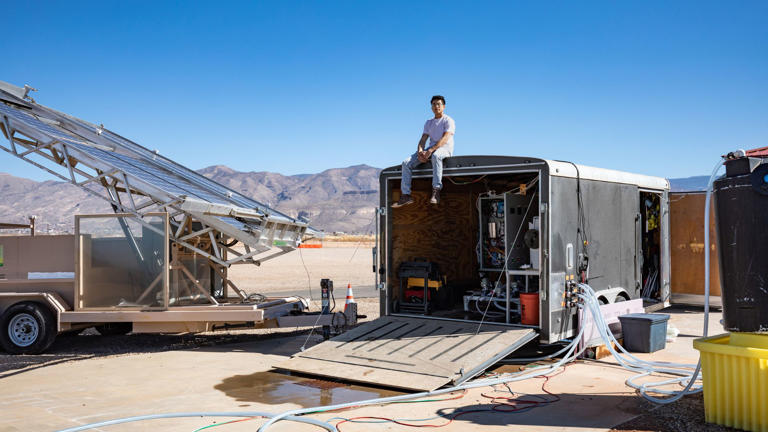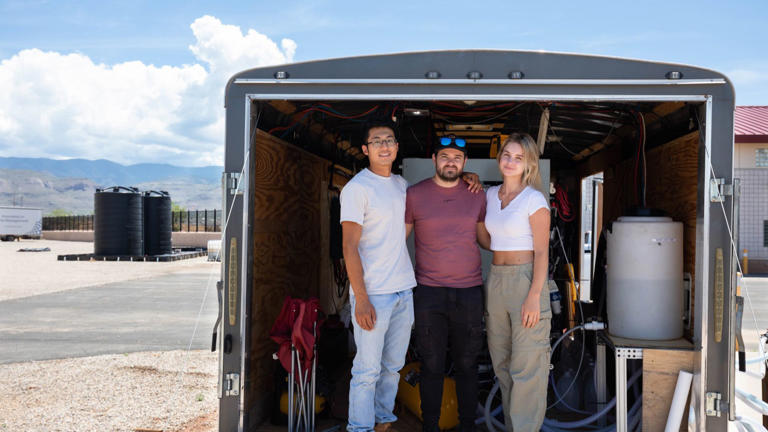MIT’s new battery-free solar desalination system dances with Sun’s rhythm
• 1d • 3 min read
Researchers have created a novel desalination system that runs with the rhythms of the sun.
The MIT team’s solar-powered device adjusts desalination speed to match sunlight variations, increasing output as sunshine intensifies and reducing it during cloudy moments.
According to the team, the design efficiently maximizes solar energy use to produce large amounts of clean water throughout the day. Moreover, unlike other solar-powered desalination systems, the MIT design operates without additional batteries or external power sources, like grid electricity.
The system is expected to provide significant cost savings compared to conventional desalination technologies. The main savings stem from reduced energy costs, which are a major operational expense in traditional methods, particularly reverse osmosis (RO), which relies on grid power.
“Compared to RO, electrodialysis membranes usually last about three times as long,” Amos Winter, the Germeshausen Professor of Mechanical Engineering and director of the K. Lisa Yang Global Engineering and Research Center at MIT, told Interesting Engineering (IE), in an email interview.
Adapting to sunlightWinter and his team, including former MIT postdoc Wei He, built on a previous design to improve desalination through “flexible batch electrodialysis.” Unlike reverse osmosis, which uses pressure to filter salts, electrodialysis employs an electric field to remove salt ions via ion-exchange membranes.
Powering desalination with renewable energy is particularly difficult for reverse osmosis, requiring a consistent energy supply. The MIT team focused on electrodialysis, creating a system that adapts to solar energy variations.
Their model-based control system optimizes water flow and voltage for maximum salt removal. Field tests showed a 77 percent solar energy usage, significantly improving previous designs.
“We could only calculate every three minutes, and in that time, a cloud could literally come by and block the sun. The system could be saying, ‘I need to run at this high power.’ But some of that power has suddenly dropped because there’s now less sunlight. So, we had to make up that power with extra batteries,” said Winter, in a statement.
Battery-free desalinationIn their latest work, researchers eliminated the need for batteries by reducing the system’s response time to just a fraction of a second, adjusting the desalination rate three to five times per second.
This rapid adaptation allows the system to respond to sunlight changes without relying on extra power. The key innovation is a “flow-commanded current control” strategy, which adjusts water flow and electrical current based on the available solar power, maximizing desalination efficiency.
Winter explains the system continuously adjusts flow rate and current to match increasing solar power, reducing the need for battery buffering by responding quickly to changes.
The engineers integrated the new control strategy into a fully automated system designed to desalinate brackish groundwater for a small community of 3,000 people.
Tested for six months at the Brackish Groundwater National Research Facility in Alamogordo, New Mexico, the prototype operated under varying solar conditions. On average, it utilized over 94 percent of the solar panel’s electrical energy to power desalination, demonstrating high efficiency throughout the trial.
“Compared to how you would traditionally design a solar desal system, we cut our required battery capacity by almost 100 percent,” said Winter.
Aiding energy efficiencyResearchers say that while the technology could potentially be adapted for seawater desalination, it would not provide the same energy benefits as with brackish water.
“Below about 5000 ppm, total dissolved salt electrodialysis requires less energy; for typical brackish water, around 2500 ppm, electrodialysis requires about half the specific energy as RO,” Winter told IE.
Regions with prevalent brackish groundwater are ideal candidates for this technology. More than half of the global population lives over 100 km from the coast, making seawater desalination impractical. Areas with high water stress, such as India, North Africa, and the Middle East, present promising markets.
The team’s latest controller improves response time to further the system’s response time or energy efficiency, minimizing the need for energy buffering during fluctuations.
“Our controllers make adjustments to the system many times per second, so they are quite reactive to the weather, as indicated by our ability to capture 94 percent of the electrical energy produced by the solar panels,” said Winter.
The details of the team’s research were published in the journal Nature Water.

MIT’s new battery-free solar desalination system dances with Sun’s rhythm

MIT’s new battery-free solar desalination system dances with Sun’s rhythm

The team members in front of the electrodialysis desalination system during an installation in July. |







